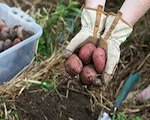One of the most important staple foods is the Irish potato...

Enough of the early crop should be grown to last until frost; and in Upper South, enough of the summer-fall crop to last through winter. Fall crops in the Lower South are quite uncertain because of hot, dry weather.
A reasonably fertile soil not too rich in nitrogen is needed for Irish potatoes. Too much nitrogen usually causes too much top growth and not enough tubers. Six to 10 pounds of a 4-12-12 or 5-10-10 per 100 feet of row or 1,200 to 2,000 pounds per acre is about right.
As for most crops, best results are obtained from fertilizer applied in bands 2 to 3 inches on either side of seed pieces and a couple of inches deeper. If put in bottom of drill, mix fertilizer with the soil thoroughly or cover with a couple of inches of soil, planting seed pieces on top of it. If pieces come in direct contact with fertilizer, poor stands will result.
Plow soil to potatoes when cultivating so they are "laid-by" on a high bed. If planted in good soil and a good crop is produced, yield should be about 18 to 1 that is, 18 bushels or pecks for each bushel or peck of seed planted.
To get good yields, plant heavy, blocky seed pieces. Skimp on seed and the yield is sure to be comparatively skimpy. One eye is sufficient, but there is no objection to two or more. Each seed piece should weigh at least 2 to 3 ounces. This is about the size of a hen egg.
After ground is well prepared, lay off rows 3 to 3 1/2 feet wide, applying fertilizer a week or 10 days ahead of time. Plant one seed piece to each 10 to 15 inches. Cover 3 l/2 to 4 inches deeper on heavy clay soil and about an inch or two deeper on sandy soils.
After ground is thoroughly prepared, lay off rows 31/2 to 4 feet wide. Bed on the furrow and let settle a few days to a week or two. Just ahead of the setters, run over bed with harrow or other implement to knock down bed somewhat and kill any germinating weeds.
Set plants close, 10 to 12 inches apart. Such distance will give more potatoes of proper size than if more distance is given, where they are to be dug quite early, set 15 to 18 inches apart. Lay them by on a ridge about 10 inches high for higher yield and better shaped roots.
Only cultivation needed is just enough to kill weeds and grass as quickly as they come through the ground and to prevent a crust from forming.
Dig potatoes when vines turn yellow but before frost has killed the vines. If frost should kill vines before potatoes are dug, get them out immediately. Even slight frost will damage sweet potatoes, although it may not become evident until after several weeks of storage.
When digging, plow deep enough to prevent cutting any roots. Pick up and place directly in baskets or boxes in which they are to be moved from the field. It's also best to store in the same container. Less bruising and skinning of roots will result when they are handled in this manner. Handle so as not to bruise.
For storing, a small house, in which the temperature can be controlled with a thermostat, is much preferred. When stored in this manner, sweet potatoes should be cured for a week or so at 85 degrees F. and then temperature lowered to about 55 degrees F. Never expose sweet potatoes to temperatures lower than 50 degrees F. or cold injury will develop. Better curing and less shrinkage will occur if the air moisture is kept fairly high, about 85 to 95% relative humidity. Therefore, ventilate only enough to prevent moisture from condensing on walls or ceiling.
